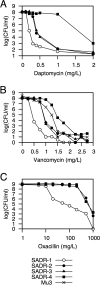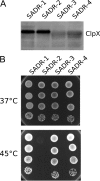Stepwise decrease in daptomycin susceptibility in clinical Staphylococcus aureus isolates associated with an initial mutation in rpoB and a compensatory inactivation of the clpX gene
- PMID: 26324273
- PMCID: PMC4604412
- DOI: 10.1128/AAC.01303-15
Stepwise decrease in daptomycin susceptibility in clinical Staphylococcus aureus isolates associated with an initial mutation in rpoB and a compensatory inactivation of the clpX gene
Abstract
Daptomycin is a lipopeptide antibiotic used clinically for the treatment of methicillin-resistant Staphylococcus aureus (MRSA) infections. The emergence of daptomycin-nonsusceptible S. aureus isolates during therapy is often associated with multiple genetic changes; however, the relative contributions of these changes to resistance and other phenotypic changes usually remain unclear. The present study was undertaken to investigate this issue using a genetically characterized series of four isogenic clinical MRSA strains derived from a patient with bacteremia before and during daptomycin treatment. The first strain obtained after daptomycin therapy carried a single-nucleotide polymorphism (SNP) in rpoB (RpoB A477D) that decreased susceptibility not only to daptomycin but also to vancomycin, β-lactams, and rifampin. Furthermore, the rpoB mutant exhibited pleiotropic phenotypes, including increased cell wall thickness, reduced expression of virulence traits, induced expression of the stress-associated transcriptional regulator Spx, and slow growth. A subsequently acquired loss-of-function mutation in clpX partly alleviated the growth defect conferred by the rpoB mutation without changing antibiotic susceptibility. The final isolate acquired three additional mutations, including an SNP in mprF (MprF S295L) known to confer daptomycin nonsusceptibility, and accordingly, this isolate was the only daptomycin-nonsusceptible strain of this series. Interestingly, in this isolate, the cell wall had regained the same thickness as that of the parental strain, while the level of transcription of the vraSR (cell wall stress regulator) was increased. In conclusion, this study illustrates how serial genetic changes selected in vivo contribute to daptomycin nonsusceptibility, growth fitness, and virulence traits.
Copyright © 2015, American Society for Microbiology. All Rights Reserved.
Figures





References
-
- Peleg A, Miyakis S, Ward D, Earl A, Rubio A, Cameron D, Pillai S, Moellering RJ, Eliopoulos G. 2012. Whole genome characterization of the mechanisms of daptomycin resistance in clinical and laboratory derived isolates of Staphylococcus aureus. PLoS One 7:e28316. doi:10.1371/journal.pone.0028316. - DOI - PMC - PubMed
Publication types
MeSH terms
Substances
LinkOut - more resources
Full Text Sources

